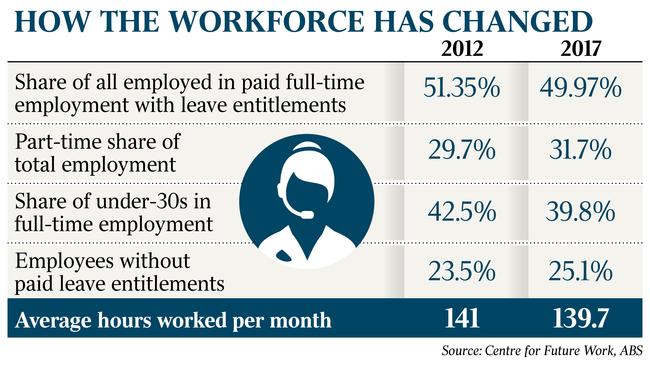Traditional full-time permanent jobs no longer the norm
For the first time on record, less than half of Australian workers are in a permanent full-time job with leave entitlements.

For the first time in recorded statistics, less than half of Australian workers are in a permanent full-time paid job with leave entitlements, according to research highlighting the rapid growth in insecure employment.
Analysis by the Australia Institute’s Centre for Future Work found full-time paid jobs with normal leave entitlements fell to 49.97 per cent of all employment in 2017, from 51.35 per cent in 2012. Over the same period, the share of part-time jobs rose two percentage points to 31.7 per cent, the highest in Australian history, and the share of workers without paid leave entitlements in casual jobs added 1.6 percentage points to 25.1 per cent.
Underemployment, the number of workers who want more hours, jumped from 7.6 per cent to 9.1 per cent over the five years to 2017, while average hours worked each month fell from 141 to 139.7.

The research by economists Tanya Carney and Jim Stanford, based on analysis of Australian Bureau of Statistics data, concluded the traditional employment relationship based on permanent full-time work with entitlements such as paid leave and superannuation “has been chipped away on many sides”.
“Today, for the first time in recorded statistics, less than half of employed Australians work in a permanent full-time paid job with leave entitlements,’’ they said.
Dr Stanford said yesterday the fact that more than half of workers no longer fitted into the traditional stereotype of a permanent full-time paid job with entitlements showed “the world of work has really changed”.
“Less than half of Australians can imagine work with the sort of permanency and entitlements that we once took for granted,’’ he said. The percentage of casual employment had been “as high, a couple of times in history, at peak periods”.
“But I think it’s a mistake to focus on just that one particular indicator. Casual work has clearly grown over the last five years. It’s grown quite significantly but the bigger point is that all of the other dimensions of employment security have eroded away at the same time,’’ Dr Stanford said.
Workplace Minister Craig Laundy has said insecure work has not become more common, and employers maintain casual employment suits many workers who want flexible arrangements.
“Casual work is a completely appropriate way for many businesses and many employees to conduct their relationship,’’ he told ABC radio in March.
And Prime Minister Malcolm Turnbull has argued the rate of casual employment has “been the same for decades”.
The research found the share of Australians under 30 in full-time employment fell from 42.5 per cent in 2012 to 38.9 per cent in 2017. The share of private-sector workers covered by enterprise agreements fell one-third from 18.9 per cent to 12.4 per cent, and the share of workers under awards jumped from 16.6 per cent to 23.6 per cent.
Dr Stanford said many young people had internalised the fact that they might never have permanent jobs.
“If we let that become a reality, the consequences for family stability and household finances and home ownership … are going to be enormous,’’ he said. “Yes, we can celebrate flexibility, we can celebrate entrepreneurship but … we need something reliable if you are going to buy a house, send your kids to university and plan to retire with decency.”




To join the conversation, please log in. Don't have an account? Register
Join the conversation, you are commenting as Logout